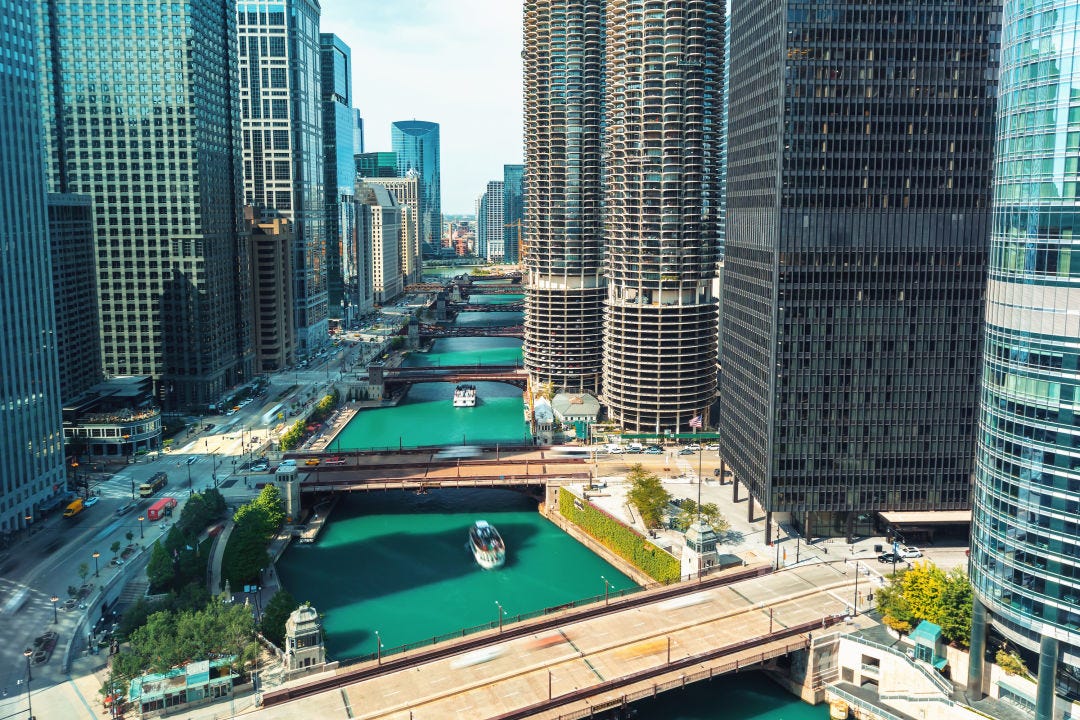Climate change affecting building foundations
Climate change warms buildings that warm the ground on which they are built, and that's not good
As you probably already know, it is through your support that I am able to continue writing and publishing this newsletter. One of the best ways you can show that support is by sharing The Green Dispatch. It may not seem like much, but it’s a big help. If you appreciate this article on the science of climate change and buildings, or The Green Dispatch in general, please click the share button below.
I briefly visited Chicago last fall. Although it was October, the weather was very pleasant for a day or two, and I took advantage of the sunny skies and balmy breezes to walk around and admire the city. I wandered the streets for a while, indulged in a Chicago-style hot dog, then headed along the lakefront and ultimately strolled along the Riverwalk. All the while, I took in and admired the great skyscrapers the city is famous for.
Those towering structures, and even some of the less towering ones, may be threatened by climate change. A recent study found that climate change is warming the ground underneath Chicago. That warming can cause expansion of the rock and clay underneath and around the foundations of buildings, threatening their structural integrity.
Alessandro F. Rotta Loria, an Assistant Professor of Civil and Environmental Engineering at Northwestern University assessed the warming underneath Chicago. While his findings do not predict the fall of any skyscrapers anytime soon, they do suggest some trouble for Chicago’s structures and urban buildings throughout the world. Rotta Loria focused his study on the Loop, the central business district of Chicago. When most folks think of Chicago, they are thinking of the Loop. It’s home to the giant buildings, such as the Willis Tower and Trump Tower, as well as the famous Wrigley building and Tribune Tower. The study was published in Communications Engineering this month.

Rotta Loria collected data from more than 150 thermostats installed in parking garages, subway tunnels, and other underground places in the Loop. He also placed thermostats under Grant Park, along the shore of Lake Michigan. While the park has paved walkways and a few structures, a great deal of its more than 300 acres is open green space, so it offered good adjacent comparison data.
Using data from the sensors collected over a three-year period, Rotta Loria created a 3-D computer model of the Loop, starting the model in 1951, when the subway tunnels in the Loop were completed and the subterranean character of Chicago’s downtown took on its present profile. Some of the findings indicate that in the recent past, subterranean Chicago warmed at about 0.9° F a year, but recently that has slowed to about 0.25° F. a year. This is an average, as the warming is not uniform and varies according to where the heat is coming from, differences in the bedrock, and variations in groundwater flow.
How cities warm the earth on which they are built
Cities warm the underlying ground in two ways. Most of the heat comes from the buildings themselves. As we heat a structure during chilly weather, some of that heat transfers to the surrounding ground. Cars passing through urban tunnels, even the heat generated from subway brakes warm the surrounding dirt and stone. Heat from high-voltage cables and sewers warms the sub-urban world as well.
The other cause of subterranean warming is from what is called the urban heat island effect, the phenomenon of cities being warmer than the surrounding countryside. It’s pretty fundamental and affects even smaller cities. As far back as the time of Julius Caesar, the Romans noticed that their Eternal City was warmer than the surrounding country. Asphalt, concrete, steel, bricks, and just about everything used to construct a city traps heat when it’s warmed by the sun. That heat then radiates to the surroundings of a city. We feel it in warmer air temperatures. But that heat also radiates into the ground.
Surprisingly, the underground urban heat island can be more pronounced than the above-ground heat island. With global heating causing an increase of 0.3 and 8° F in the underground temperature (down to 100 feet) every decade. Studies have already shown that the underground warming affects everything from soil composition to the groundwater under a city, with implications on plant life and pollution. This heating affects subway tracks, slowing down trains.
The warming expands the clay and rock upon which towers, roads, and buildings rest. Factoring climate change into his 3-D model and projecting into the future, to 2051, Rotta Loria found that these materials can rise as much as half an inch or subside by one third of an inch due to human caused heating. This may not seem like much, but like the small roots that crack pavement, this displacement can affect building foundations and earth retaining walls.

The problems with buildings in the Loop that have cropped up in the past—excessive settlements of foundations, buildings that bulge or lean, etc.—have been blamed on design or construction faults. Rotta Loria suggests that many of these problems may have been caused by the warming of the ground.
The paper’s author suggests that climate change and its effects on the subsurface of a city should be part of the planning of construction, that future warming should be taken into account to ensure the structural integrity of Chicago and other cities in the future. And though he admits that harvesting this man-made geothermal heat may prove to be impractical, he suggests that this wasted resource should be looked at as a means of heating Chicago’s downtown buildings.






I have to admit, this was one of the few effects of climate change and environmental degradation that I did NOT consider for my forthcoming novel. Another thing to worry about!